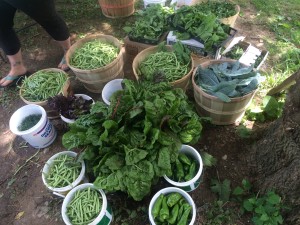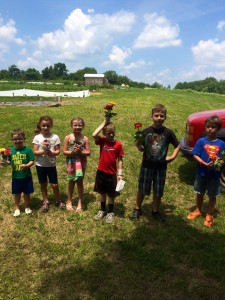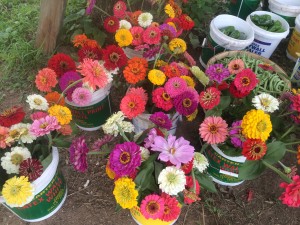The Old Log Cabin and The Brick House
The New Vrindaban Advocacy Sanga met with Jaya Krsna prabhu on Tues. July 5, 2014. One of the topics that came up was the recent removal of the old log cabin that used to sit just off the road across from Srila Prabhupada’s Palace of gold. It was made of massive, thick logs and, at one time, was an attractive remnant from the Limestone area’s past. Over the years, there have been various additions and subtractions made on the cabin. Acting on inquiries from residents of the community, who noticed with some surprise that the cabin was being dismantled, the Advocacy Sanga brought up the topic with Jaya Krsna on behalf of the residents.
According to Jaya Krsna, although the log cabin has been taken down, it will be re-used as a temple for Krsna for the devotees living in the area of Yudhisthira’s land.
Jaya Krsna explained, “There are a few reasons why the log cabin has been removed. First of all (but not necessarily in order of importance) New Vrindaban has been doing a lot of promotion over the last two years to bring back visitors and buses to Srila Prabhupada’s Palace of Gold. This includes TV spots in Pittsburgh, ads in tourism magazines, as well as distributing flyers to a wider area than we have done in a long time.
to bring back visitors and buses to Srila Prabhupada’s Palace of Gold. This includes TV spots in Pittsburgh, ads in tourism magazines, as well as distributing flyers to a wider area than we have done in a long time. As a result, we have experienced that more buses and tourists are coming. Our Palace parking lot is not big enough to accommodate all the vehicles. At the beginning of the season, two spaces for tour buses have already been realized.
Jaya Krsna went on, “Another reason concerns the history of this cabin. Some people thought that the cabin was a significant historic building, in which case we would not want to remove it, but rather have it certified and marked as such. However, after some research, Varsana Maharaj discovered that the cabin had been a church built in 1810, originally in Limestone, but had been moved two times prior to settling where it was for some years now, across from the Palace. It was not at all connected with the historic Wetzel family, as many people thought – a family who had settled the current area of New Vrindaban back in frontier days. In addition, when Yudhisthira recently approached the Marshall County Historical Society, they showed no interest, nor did they give any historical significance to the cabin.”
According to Jaya Krsna, the third reason for removing the cabin is related to Varsana Maharaj’s Govardhana Hill and Sri Sri Radha Gopinath Mandir project. There have been plans in place for many years to construct this small replica of Vrindavan Dhama in New Vrindaban in the area of Govardhana Hill, a region which includes the log cabin as well as the brick house (Kirtanananda Swami’s old house). Just a couple of years ago, when some professsors from WVU did research work on the topic of holy places of pilgrimage in New Vrindaban, they recommended that, for optimum effectiveness, there should be no buildings obstructing the view or the access between the Palace and Govardhana Hill.
This is a fact which has already been proven at the recent July 4 festival. Visitors were seen leaving their Palace tour, and then walking directly up to the Sri Sri Radha Gopinatha Mandir, which was now clearly visible due to the removal of the cabin.
“Finally,” Jaya Krsna reminded everyone, “the decision about the log cabin was discussed at the April joint Board meetings and then presented to the community during the community dialog that same weekend.
The Brick House
The brick house, still standing next to where the log cabin was situated, originally belonged to non-devotees, but was bought by the community in 1980, and ultimately became Kirtanananda Swami’s residence for some years, with a men’s asrama downstairs. After he left the community in 1994, the brick house was used as living quarters for one family upstairs, and offices for the Palace downstairs. But then, the house remained empty for many years and fell into disrepair. Eventually, there was a new roof put in, and the basement was gutted in order to eliminate the black mold, all in an effort to possibly make the house useful again. However, due to various changes in New Vrindaban at the time, the house was never again used to this date, and is now in even worse shape.
Jaya Krsna says that this house will also soon be taken down and partially re-used, in order to further clear that area for the Govardhana Hill project, which is meant to help fulfill the part of Srila Prabhupada’s vision for New Vrindaban as a place of pilgrimage.








 Srimad-Bhagavatam 6.18.52 Purport:
“If one is trained to honor and worship the cows and brahmanas, he is actually civilized. The worship of the Supreme Lord is recommended, and the Lord is very fond of the cows and brahmanas (namo brahmanya-devaya go-brahmana-hitaya ca). In other words, a civilization in which there is no respect for the cows and brahmanas is condemned. One cannot become spiritually advanced without acquiring the brahminical qualifications and giving protection to cows.
Srimad-Bhagavatam 6.18.52 Purport:
“If one is trained to honor and worship the cows and brahmanas, he is actually civilized. The worship of the Supreme Lord is recommended, and the Lord is very fond of the cows and brahmanas (namo brahmanya-devaya go-brahmana-hitaya ca). In other words, a civilization in which there is no respect for the cows and brahmanas is condemned. One cannot become spiritually advanced without acquiring the brahminical qualifications and giving protection to cows.  Hari Bol. My name is Bal Gopal das. My wife Lalita Sundari and I are residents of New Dvaraka Dham. Last February my daughter Gauri had her 7th birthday. A television show named Take Me To Your Mother came to film how Hare Krishnas celebrate birthday parties.
Last night the episode on television. It is on NickMoms or Nickelodeon which is a very famous channel in America. I thought this is newsworthy for the devotees. Below is the link to the show which you can watch online
Hari Bol. My name is Bal Gopal das. My wife Lalita Sundari and I are residents of New Dvaraka Dham. Last February my daughter Gauri had her 7th birthday. A television show named Take Me To Your Mother came to film how Hare Krishnas celebrate birthday parties.
Last night the episode on television. It is on NickMoms or Nickelodeon which is a very famous channel in America. I thought this is newsworthy for the devotees. Below is the link to the show which you can watch online 

 “One who chants Krishna's name and constantly remembers Him, even though living in this material ocean of nescience, is like the lotus, which is born in the water but is untouched by it: it's position is transcendental. This great soul is capable of liberating all the suffering residents of the hellish planets. (Varaha Purana)
“One who chants Krishna's name and constantly remembers Him, even though living in this material ocean of nescience, is like the lotus, which is born in the water but is untouched by it: it's position is transcendental. This great soul is capable of liberating all the suffering residents of the hellish planets. (Varaha Purana)